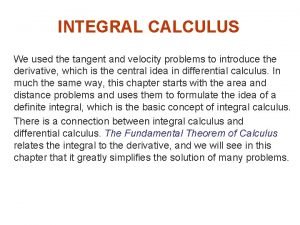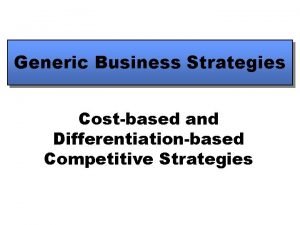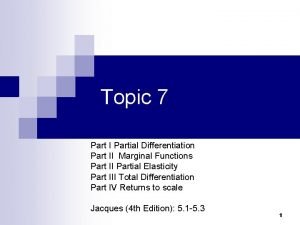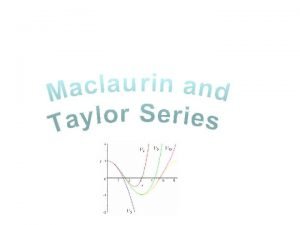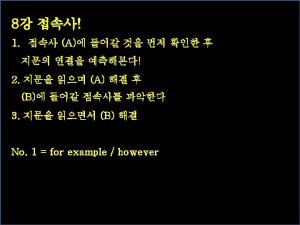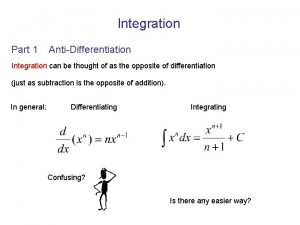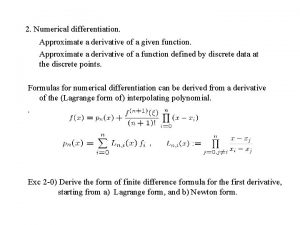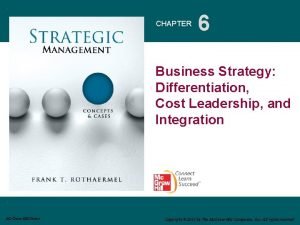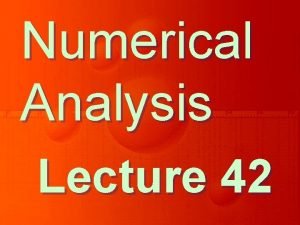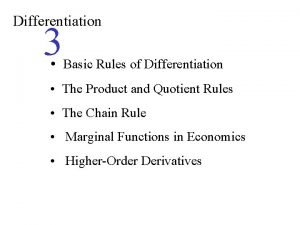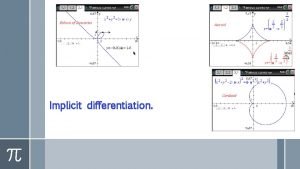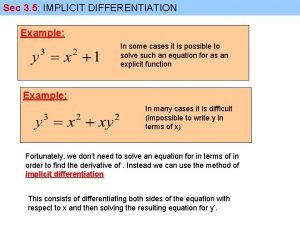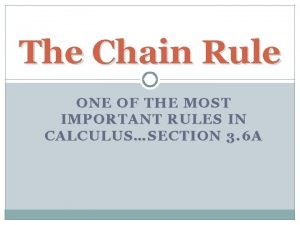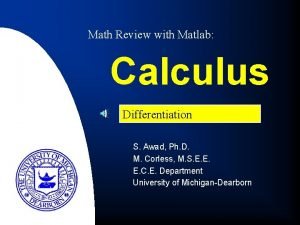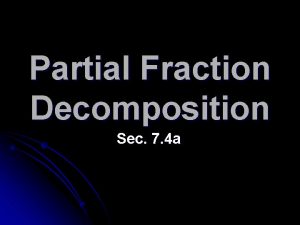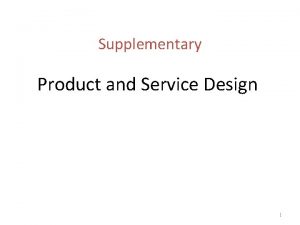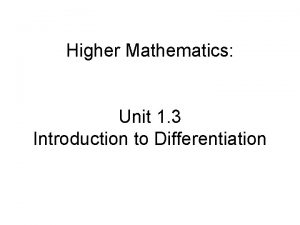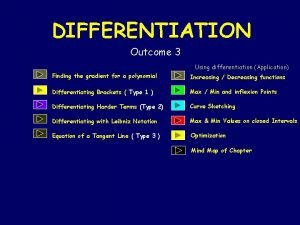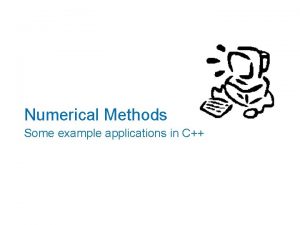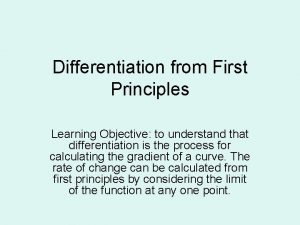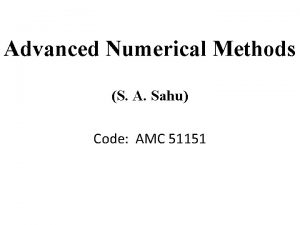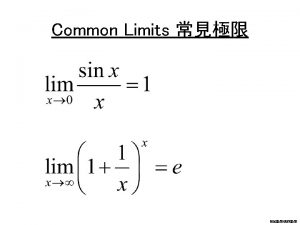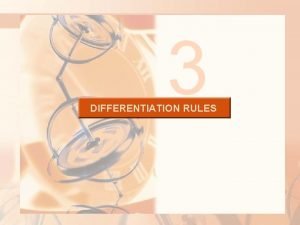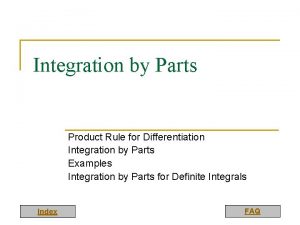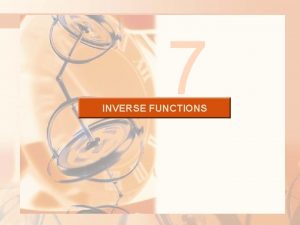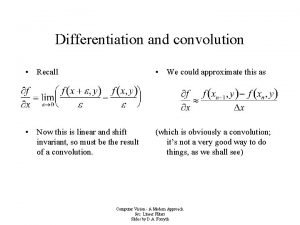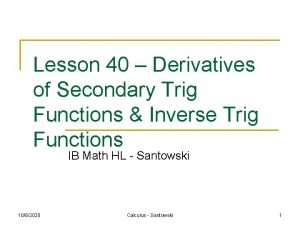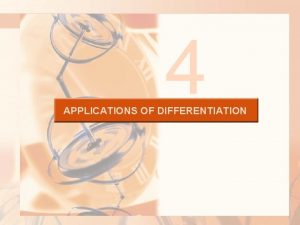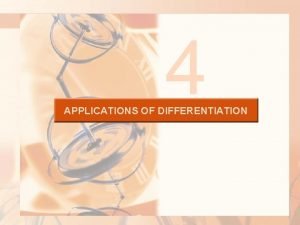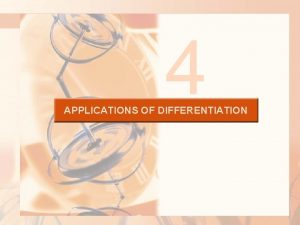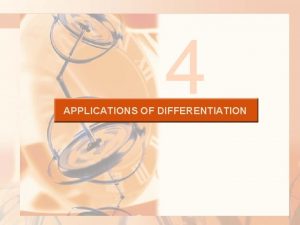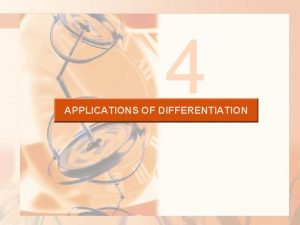4 APPLICATIONS OF DIFFERENTIATION APPLICATIONS OF DIFFERENTIATION 4

























































- Slides: 57

4 APPLICATIONS OF DIFFERENTIATION

APPLICATIONS OF DIFFERENTIATION 4. 4 Indeterminate Forms and L’Hospital’s Rule In this section, we will learn: How to evaluate functions whose values cannot be found at certain points.

INDETERMINATE FORMS Suppose we are trying to analyze the behavior of the function Although F is not defined when x = 1, we need to know how F behaves near 1.

INDETERMINATE FORMS Expression 1 In particular, we would like to know the value of the limit

INDETERMINATE FORMS In computing this limit, we can’t apply Law 5 of limits (Section 2. 3) because the limit of the denominator is 0. § In fact, although the limit in Expression 1 exists, its value is not obvious because both numerator and denominator approach 0 and is not defined.

INDETERMINATE FORM —TYPE 0/0 In general, if we have a limit of the form where both f(x) → 0 and g(x) → 0 as x → a, then this limit may or may not exist. It is called an indeterminate form of type § We met some limits of this type in Chapter 2. .

INDETERMINATE FORMS For rational functions, we cancel common factors:

INDETERMINATE FORMS We used a geometric argument to show that:

INDETERMINATE FORMS However, these methods do not work for limits such as Expression 1. § Hence, in this section, we introduce a systematic method, known as l’Hospital’s Rule, for the evaluation of indeterminate forms.

INDETERMINATE FORMS Expression 2 Another situation in which a limit is not obvious occurs when we look for a horizontal asymptote of F and need to evaluate the limit

INDETERMINATE FORMS It isn’t obvious how to evaluate this limit because both numerator and denominator become large as x → ∞. There is a struggle between the two. § If the numerator wins, the limit will be ∞. § If the denominator wins, the answer will be 0. § Alternatively, there may be some compromise— the answer may be some finite positive number.

INDETERMINATE FORM —TYPE ∞/∞ In general, if we have a limit of the form where both f(x) → ∞ (or -∞) and g(x) → ∞ (or -∞), then the limit may or may not exist. It is called an indeterminate form of type ∞/∞.

INDETERMINATE FORMS We saw in Section 2. 6 that this type of limit can be evaluated for certain functions— including rational functions—by dividing the numerator and denominator by the highest power of x that occurs in the denominator. § For instance,

INDETERMINATE FORMS This method, though, does not work for limits such as Expression 2. § However, L’Hospital’s Rule also applies to this type of indeterminate form.

L’HOSPITAL’S RULE Suppose f and g are differentiable and g’(x) ≠ 0 on an open interval I that contains a (except possibly at a). Suppose or that § In other words, we have an indeterminate form of type or ∞/∞.

L’HOSPITAL’S RULE Then, if the limit on the right exists (or is ∞ or - ∞).

NOTE 1 L’Hospital’s Rule says that the limit of a quotient of functions is equal to the limit of the quotient of their derivatives—provided that the given conditions are satisfied. § It is especially important to verify the conditions regarding the limits of f and g before using the rule.

NOTE 2 The rule is also valid for one-sided limits and for limits at infinity or negative infinity. § That is, ‘x → a’ can be replaced by any of the symbols x → a+, x → a-, x → ∞, or x → - ∞.

NOTE 3 For the special case in which f(a) = g(a) = 0, f’ and g’ are continuous, and g’(a) ≠ 0, it is easy to see why the rule is true.

NOTE 3 In fact, using the alternative form of the definition of a derivative, we have:

NOTE 3 It is more difficult to prove the general version of l’Hospital’s Rule.

L’HOSPITAL’S RULE Example 1 Find § and § Thus, we can apply l’Hospital’s Rule:

L’HOSPITAL’S RULE Example 2 Calculate § We have and § So, l’Hospital’s Rule gives:

L’HOSPITAL’S RULE Example 2 As ex → ∞ and 2 x → ∞ as x → ∞, the limit on the right side is also indeterminate. However, a second application of l’Hospital’s Rule gives:

L’HOSPITAL’S RULE Example 3 Calculate § As ln x → ∞ and l’Hospital’s Rule applies: as x → ∞, § Notice that the limit on the right side is now indeterminate of type.

L’HOSPITAL’S RULE Example 3 § However, instead of applying the rule a second time as we did in Example 2, we simplify the expression and see that a second application is unnecessary:

L’HOSPITAL’S RULE Example 4 Find § Noting that both tan x – x → 0 and x 3 → 0 as x → 0, we use l’Hospital’s Rule:

L’HOSPITAL’S RULE Example 4 § As the limit on the right side is still indeterminate of type , we apply the rule again:

L’HOSPITAL’S RULE Example 4 § Since , we simplify the calculation by writing:

L’HOSPITAL’S RULE Example 4 § We can evaluate this last limit either by using l’Hospital’s Rule a third time or by writing tan x as (sin x)/(cos x) and making use of our knowledge of trigonometric limits.

L’HOSPITAL’S RULE Example 4 Putting together all the steps, we get:

L’HOSPITAL’S RULE Example 5 Find § If we blindly attempted to use l-Hospital’s rule, we would get:

L’HOSPITAL’S RULE Example 5 This is wrong. § Although the numerator sin x → 0 as x → π -, notice that the denominator (1 - cos x) does not approach 0. § So, the rule can’t be applied here.

L’HOSPITAL’S RULE Example 5 The required limit is, in fact, easy to find because the function is continuous at π and the denominator is nonzero there:

L’HOSPITAL’S RULE The example shows what can go wrong if you use the rule without thinking. § Other limits can be found using the rule, but are more easily found by other methods. § See Examples 3 and 5 in Section 2. 3, Example 3 in Section 2. 6, and the discussion at the beginning of the section.

L’HOSPITAL’S RULE So, when evaluating any limit, you should consider other methods before using l’Hospital’s Rule.

INDETERMINATE PRODUCTS If and then it isn’t clear what the value of , if any, will be. (or -∞),

INDETERMINATE PRODUCTS There is a struggle between f and g. § If f wins, the answer will be 0. § If g wins, the answer will be ∞ (or -∞). § Alternatively, there may be a compromise where the answer is a finite nonzero number.

INDETERMINATE FORM—TYPE 0. ∞ This kind of limit is called an indeterminate form of type 0. ∞. § We can deal with it by writing the product fg as a quotient: § This converts the given limit into an indeterminate form of type or ∞/∞, so that we can use l’Hospital’s Rule.

INDETERMINATE PRODUCTS Example 6 Evaluate § The given limit is indeterminate because, as x → 0+, the first factor (x) approaches 0, whereas the second factor (ln x) approaches -∞.

INDETERMINATE PRODUCTS Example 6 § Writing x = 1/(1/x), we have 1/x → ∞ as x → 0+. § So, l’Hospital’s Rule gives:

INDETERMINATE PRODUCTS Note In solving the example, another possible option would have been to write: § This gives an indeterminate form of the type 0/0. § However, if we apply l’Hospital’s Rule, we get a more complicated expression than the one we started with.

INDETERMINATE PRODUCTS Note In general, when we rewrite an indeterminate product, we try to choose the option that leads to the simpler limit.

INDETERMINATE FORM—TYPE ∞ If -∞ and the limit is called an indeterminate form of type ∞ - ∞. , then

INDETERMINATE DIFFERENCES Again, there is a contest between f and g. § Will the answer be ∞ (f wins)? § Will it be - ∞ (g wins)? § Will they compromise on a finite number?

INDETERMINATE DIFFERENCES To find out, we try to convert the difference into a quotient (for instance, by using a common denominator, rationalization, or factoring out a common factor) so that we have an indeterminate form of type or ∞/∞.

INDETERMINATE DIFFERENCES Example 7 Compute § First, notice that sec x → ∞ and tan x → ∞ as x → (π/2). § So, the limit is indeterminate.

INDETERMINATE DIFFERENCES Example 7 Here, we use a common denominator: § Note that the use of l’Hospital’s Rule is justified because 1 – sin x → 0 and cos x → 0 as x → (π/2).

INDETERMINATE POWERS Several indeterminate forms arise from the limit

INDETERMINATE POWERS Each of these three cases can be treated in either of two ways. § Taking the natural logarithm: § Writing the function as an exponential:

INDETERMINATE POWERS Recall that both these methods were used in differentiating such functions. § In either method, we are led to the indeterminate product g(x) ln f(x), which is of type 0. ∞.

INDETERMINATE POWERS Example 8 Calculate § First, notice that, as x → 0+, we have 1 + sin 4 x → 1 and cot x → ∞. § So, the given limit is indeterminate.

INDETERMINATE POWERS Example 8 Let y = (1 + sin 4 x)cot x Then, ln y = ln[(1 + sin 4 x)cot x] = cot x ln(1 + sin 4 x)

INDETERMINATE POWERS So, l’Hospital’s Rule gives: Example 8

INDETERMINATE POWERS Example 8 So far, we have computed the limit of ln y. However, what we want is the limit of y. § To find this, we use the fact that y = eln y:

INDETERMINATE POWERS Example 9 Find § Notice that this limit is indeterminate x since 0 = 0 for any x > 0 but x 0 = 1 for any x ≠ 0.

INDETERMINATE POWERS Example 9 We could proceed as in Example 8 or by writing the function as an exponential: xx = (eln x)x = ex ln x § In Example 6, we used l’Hospital’s Rule to show that § Therefore,
 Integral of tangent
Integral of tangent Contoh soal turunan fungsi vektor
Contoh soal turunan fungsi vektor Leukemia conclusion
Leukemia conclusion A differentiation-based competitive advantage
A differentiation-based competitive advantage Orthogonal unit differentiation
Orthogonal unit differentiation Augmented product example
Augmented product example Rate of change differentiation
Rate of change differentiation Eigen
Eigen Integrated cost leadership/differentiation strategy
Integrated cost leadership/differentiation strategy Partial differentiation
Partial differentiation Differentiation recap
Differentiation recap For example 접속사
For example 접속사 Antidifferentiation
Antidifferentiation Differentiation grids
Differentiation grids Numerical differentiation
Numerical differentiation Differentiation dr frost
Differentiation dr frost Segmentation targeting differentiation and positioning
Segmentation targeting differentiation and positioning Science differentiation in action
Science differentiation in action Selecting an overall positioning strategy
Selecting an overall positioning strategy Differentiation cost leadership
Differentiation cost leadership What is your real self and ideal self?
What is your real self and ideal self? Differentiation vs scaffolding
Differentiation vs scaffolding Numerical differentiation examples
Numerical differentiation examples Differentiation of sin inverse x
Differentiation of sin inverse x Chain rule differentiation
Chain rule differentiation Implicit differentiation
Implicit differentiation Trigonometric identities derivatives
Trigonometric identities derivatives Chain rule outside inside
Chain rule outside inside Paraxial mesoderm
Paraxial mesoderm Guyton physiology lectures
Guyton physiology lectures Differentiation in matlab
Differentiation in matlab The pitfalls of a differentiation strategy include
The pitfalls of a differentiation strategy include Integrity vs despair
Integrity vs despair Vector differentiation
Vector differentiation Difference between udl and differentiation
Difference between udl and differentiation Partial fraction
Partial fraction Designs may be frozen with too many imperfections remaining
Designs may be frozen with too many imperfections remaining Differentiation syndrome
Differentiation syndrome Specialization vs differentiation
Specialization vs differentiation Log and exponential derivatives
Log and exponential derivatives Differentiation
Differentiation Differentiation by outcome
Differentiation by outcome Numerical differentiation c++
Numerical differentiation c++ Product rule example
Product rule example Differentiation from first principles
Differentiation from first principles Newton backward interpolation formula
Newton backward interpolation formula How to find stationary points using differentiation
How to find stationary points using differentiation Define social differentiation
Define social differentiation Partial differentiation
Partial differentiation Derivatives數學
Derivatives數學 Hyperbolic differentiation formulas
Hyperbolic differentiation formulas Differentiation by parts
Differentiation by parts 5 generic business strategies
5 generic business strategies Partial derivatives
Partial derivatives Hyperbolic differentiation formulas
Hyperbolic differentiation formulas Differentiation of convolution
Differentiation of convolution Derivative of inverse trig functions
Derivative of inverse trig functions Differentiating process examples
Differentiating process examples
